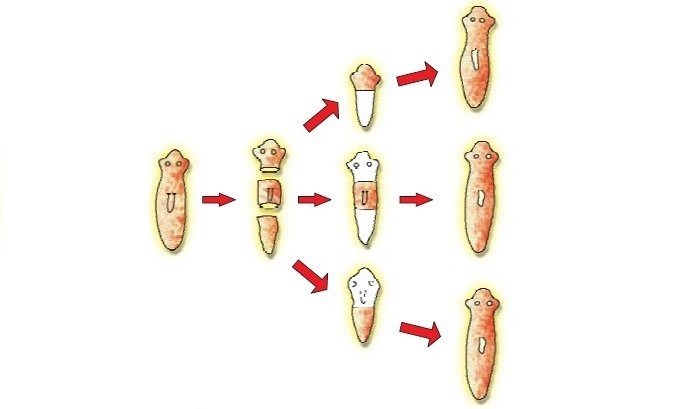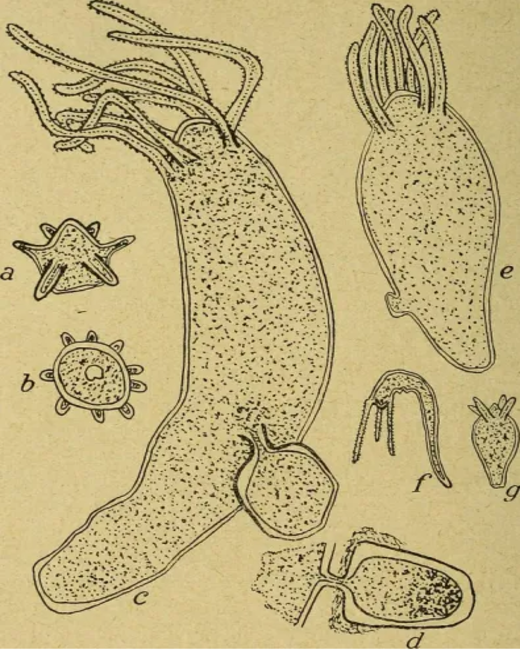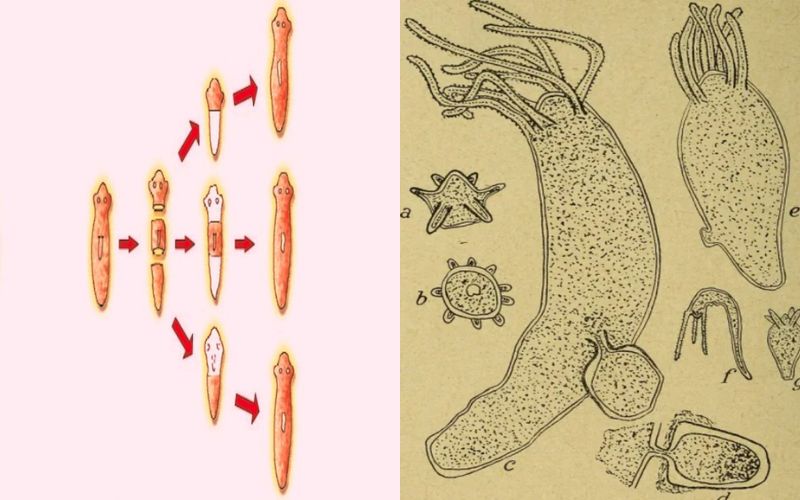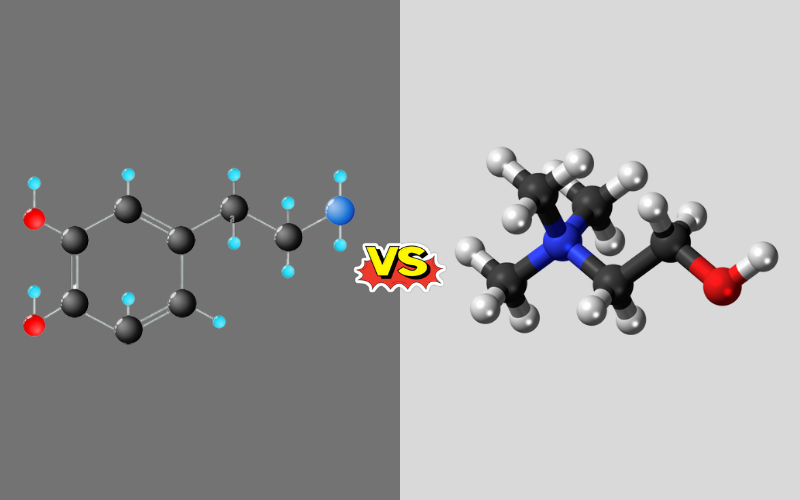Epimorphosis and Morphallaxis – Best 10 Difference
Epimorphosis and Morphallaxis
Epimorphosis and morphallaxis are two distinct methods of regeneration in biology.
Epimorphosis refers to the process of replacing damaged or lost tissues through significant cell proliferation and differentiation. Blastema forms during epimorphosis to supply undifferentiated cells for use in regeneration such as those seen in planarians and certain amphibians where lost body parts such as limbs are fully restored via this mechanism.
As opposed to epimorphosis, morphallaxis is a regeneration process that relies primarily on tissue reorganization rather than extensive cell proliferation for renewal. Unlike epimorphosis, morphallaxis doesn’t necessitate the creation of a blastema; organisms like Hydra and other lower species use it for recovering damaged or lost body parts using tissue rearrangement rather than rebuilding entire structures through this technique.
what is Epimorphosis?

Epimorphosis refers to the process of regeneration in a particular area of the body. It is characterized by the extensive cell proliferation of Somatic Stem Cells and stem cells, as well as dedifferentiation, reprogramming, and blastema growth. Epimorphosis is a basic model for the development of animals. It is only seen in the tissues around the area of injury and is not present throughout the entire organism.
A biologist named evolutionary Thomas Hunt Morgan was the first to study epimorphosis’s process. The majority of the regeneration process is a result of the process of cellular differentiation.
The process is able to restore the anatomy of the organism as well as the original polarity that existed prior to the degeneration of the tissues or structures. Epimorphosis is also observed in vertebrates as well as invertebrates. It is most common in annelids, salamanders, and planarians.
Epimorphosis occurs in the limbs of salamanders. This kind of regeneration occurs through the development of a new body part known as blastema. When amputations are detected by a significant number of stem cells that are somatic, they are able to migrate to the wounded region. They increase cell proliferation.
In the area of wounds, the blastema is formed and blastema cells multiply to rejuvenate the tissues lost. Additionally, there isn’t significant alteration in the patterns of the tissue that remains during this process.
What are the types of Epimorphosis?
Epimorphosis, or tissue regeneration through extensive cell proliferation and differentiation, refers to a form of tissue repair where damaged or lost tissues are replaced through replacement by cell division. While epimorphosis generally applies across organisms, its specific manifestations vary depending on both context and type of tissues being repaired. .
Here are some common types of epimorphosis:
- Tissue-Specific Epimorphosis: Regeneration under this form is limited to certain tissue types. For instance, amphibians like salamanders utilize epimorphosis to regenerate limbs through epimorphosis; while planarians (a form of flatworm) use tissue-specific epimorphosis to regenerate various tissues or even entire organisms through tissue regeneration.
- Partial Epimorphosis: This type involves the regeneration of only part of an injured tissue. For instance, if a lizard loses part of its tail segment due to partial epimorphosis.
- Complete Epimorphosis: With this form of metamorphosis, an entire organ or structure regenerates from scratch. For instance, salamanders regrowing an amputated leg after an operation are an example of complete epimorphosis.
- Internal Organ Epimorphosis: Zebrafish can regenerate internal organs like the heart and liver through epimorphosis, making this form of regeneration essential to medical research.
- Sequential Epimorphosis: When organisms undergo sequential epimorphosis, multiple rounds of regeneration take place at once. Planarians have demonstrated this continuous potential for tissue replacement.
what is Morphallaxis?

Morphallaxis is one of the rejuvenation organs found that is found in mammals where the bulk of the regeneration process is restructuring or exchange. This method was developed by the evolutionary biochemist Abraham Trembley.
The process of morphallaxis does not involve blastemal development as well as growth. Instead of developing blastemal or proliferative cells, in morphallaxis the tissue that is already there undergoes restructuring and then transforms into a brand of an organ or tissue.
A classic case of morphallaxis is the hydrogen. In the event that this animal is split into two parts, the separated sections create two fully functioning and separate hydra. One of the most significant characteristics of morphallaxis is the vast majority of tissue that is regenerated originates from tissue already existing within the body.
That means that one cut of the hydra is one smaller version of the hydra that was originally created. Additionally, the water molecule is roughly the same as the section that was severed.
What are the types of Morphallaxis?
Morphallaxis is a mode of tissue regeneration that relies primarily on tissue reorganization rather than extensive cell proliferation and differentiation, with minimal cell proliferation taking place during regeneration. While there aren’t specific “types” of morphallaxis like there are in epimorphosis, variations exist as to when and how this phenomenon appears in various organisms.
Here are some variations on morphallaxis:
Localized Morphallaxis: This form of morphallaxis is the most frequently seen, where regeneration takes place at the site of injury or damage. For example, if a Hydra loses parts of its body due to injury or neglect, it can go through localized morphallaxis to restore them back into place.
Systemic Morphallaxis: Under certain conditions, entire organisms can experience systemic forms of morphallaxis where not only damaged areas respond to injury by restructuring themselves or changing in response to injury – something commonly observed among lower organisms.
Plasticity in Tissue Reorganization: While not technically classified as morphallaxis, tissue rearrangement and plasticity vary among species. Some organisms may display more extensive tissue rearrangements after injury while others might display only limited changes as a response.
Regeneration of Specific Structures: While morphallaxis generally involves tissue reorganization, its specific manifestation can vary between organisms. Some organisms may regenerate body parts like tentacles or segments while others restore wider regions.
Difference Between Epimorphosis and Morphallaxis
Here’s a comparison chart summarizing the key differences between Epimorphosis and Morphallaxis:
| Aspect | Epimorphosis | Morphallaxis |
|---|---|---|
| Definition | Tissue regeneration involving cell proliferation and differentiation | Tissue regeneration involving tissue reorganization without significant cell proliferation |
| Blastema Formation | Typically involves the formation of a blastema, a cluster of undifferentiated cells | Does not involve the formation of a blastema |
| Cellular Mechanisms | Involves extensive cell proliferation and differentiation | Primarily involves tissue reorganization without extensive cell division |
| Examples | – Planarians regenerating entire organisms from fragments – Salamanders regrowing lost limbs | – Hydra regenerating body parts by reorganizing existing tissues – Some lower organisms undergoing tissue reorganization after injury |
| Extent of Tissue Replacement | Often leads to complete restoration of lost or damaged tissues | Tends to involve partial or localized tissue replacement |
| Speed of Regeneration | Regeneration may be slower due to the need for cell proliferation and differentiation | Regeneration can be relatively faster, as it relies on existing tissue rearrangement |
| Cellular Plasticity | Demonstrates significant cellular plasticity and dedifferentiation | Involves tissue plasticity but without extensive cellular dedifferentiation |
| Adaptive Significance | Suitable for situations where precise tissue replacement is required | Suitable for cases where rapid adaptation and functional recovery are essential without full tissue replacement |
| Applications | Valuable for understanding tissue regeneration, stem cell biology, and regenerative medicine | Provides insights into tissue plasticity and potential alternative regeneration strategies |
| Evolutionary Relevance | Common in some higher organisms like planarians and salamanders | Often found in simpler organisms like Hydra and certain lower species |
The Mechanisms of Epimorphosis and Morphallaxis
Mechanisms of Epimorphosis:
- Dedifferentiation: Epimorphosis often starts with the dedifferentiation of specialized cells near an injury site. Once dedifferentiated, they return to a more primitive, pluripotent state allowing them to give rise to various cell types for tissue repair.
- Blastema Formation: Epimorphosis often results in the development of a blastema, an organ-shaped sac filled with undifferentiated cells that serve as a reservoir for tissue repair and regeneration. The blastema provides the primary source of cells necessary for tissue regeneration after lost or damaged tissues have been lost or damaged.
- Proliferation: Cell proliferation within the blastema occurs through dedifferentiated cells undergoing rapid cell division, leading to an increase in their numbers, which are essential in replacing missing tissues.
- Cell Differentiation: As cell division continues, newly created cells within the blastema start to differentiate into specific types needed for tissue regeneration – this process continues until all tissues have been restored to their original structures.
Mechanisms of Morphallaxis:
- Reorganization: Morphallaxis involves the reorganization of existing tissues rather than cell proliferation; rather than dedifferentiation or dedifferentiating existing cells and tissues, this process relies on rearrangement and remodeling instead.
- Resource Redistribution: When an organism experiences injury or damage, its cells and resources from nearby locations are redistributed in order to compensate for what has been lost. This may involve cell migration as well as changes to tissue morphology to restore functional ability.
- Limited Cell Proliferation: Although morphallaxis does not involve widespread cell division like epimorphosis does, some limited division may still take place to support tissue reorganization or repair minor damages.
- Adaptation and Compensation: Morphallaxis allows an organism to adapt to injuries and recover function without necessarily replacing all lost or damaged tissues; its primary goal is maintaining overall functionality rather than exact tissue restoration.
Factors Affecting Epimorphosis and Morphallaxis
Epimorphosis and morphallaxis processes in various organisms are affected by various factors that determine success, speed, and extent of tissue regeneration.
Here are a few key influences on both processes:
- Organism Type and Regenerative Capabilities: Regenerative abilities differ substantially among species. Planarians and salamanders, for instance, are known to exhibit exceptional regeneration properties; on the other hand, human beings have limited regenerative capacities.
- Age: Younger organisms often exhibit more robust regeneration than their older counterparts, and as organisms age their ability to repair damage may decrease.
- Tissue Type: The type of tissue being regenerated can have an impactful impact on its regeneration process. Certain tissues, like skin and blood vessels, possess greater potential than others such as neurons or cardiac muscle for regeneration.
- The extent of Damage: The severity and extent of an injury are both key components in its response; minor injuries can often prompt more rapid healing while severe damage could hamper regeneration efforts.
- Environmental Conditions: Regeneration can be greatly influenced by environmental factors like temperature, humidity and nutrient availability; optimal conditions could facilitate faster and more successful regeneration.
- Genetics: Genetic factors within a species can significantly impact its regenerative ability. Some genetic variants may bolster or diminish an organism’s regenerative potential.
- Hormones and Signaling Pathways: Hormones and molecular signaling pathways play a vital role in regenerative processes, and manipulation of these can alter regeneration responses.
- Immune Responses: Your immune system can either support or impede regeneration. Inflammations and immune reactions may either promote or impede this process.
- Previous Regenerative History: An organism’s past history can impact subsequent regeneration; some organisms may regenerate more efficiently after previous regenerative events have taken place.
- Evolutionary Adaptations: Evolution can influence an organism’s regenerative capabilities. Species that have evolved in environments with frequent injuries or predation may have more robust regenerative systems than others.
- Ecological Niche: Another factor affecting an organism’s well-being can be its ecological niche. For example, species living in environments with higher injury risks may have developed more effective healing strategies over time.
Summary
Epimorphosis and Morphosis are two distinct ways of regenerative tissue in the field of biology. The process involves replacing tissue that has been damaged or gone missing through an extensive process of cell differentiation and proliferation, generally, it is followed by the development of a special cell group known as blastema. The phenomenon is seen in animals such as planarians and salamanders. It results in the exact restoration of structures that have been lost.
Morphology is a process of regeneration that is based on the restructuring of existing tissues but without any major blastema or cell growth. Organisms such as Hydra use morphallaxis and adapt to traumas through tissue rearranging.
Epimorphosis may be suitable for the precise replacement of tissues however, morphallaxis is preferred when it is necessary to achieve rapid adaption and functional recovery, without the replacement of tissues, which makes it an important component of bioplasticity and regeneration strategies.


